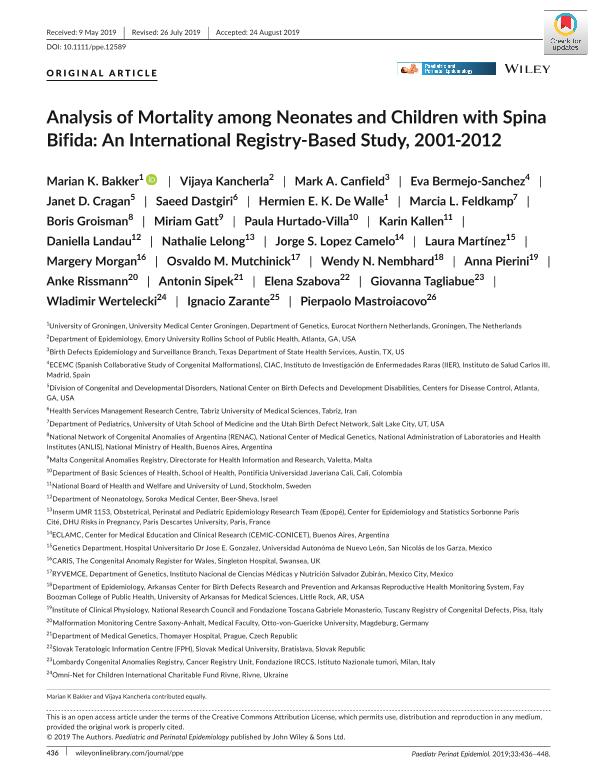Artículo
Analysis of Mortality among Neonates and Children with Spina Bifida: An International Registry-Based Study, 2001-2012
Bakker, Marian K.; Kancherla, Vijaya; Canfield, Mark A.; Bermejo-Sanchez, Eva; Cragan, Janet D.; Dastgiri, Saeed; De Walle, Hermien E. K.; Feldkamp, Marcia L.; Groisman, Boris ; Gatt, Miriam; Hurtado Villa, Paula; Kallen, Karin; Landau, Daniella; Lelong, Nathalie; López Camelo, Jorge Santiago
; Gatt, Miriam; Hurtado Villa, Paula; Kallen, Karin; Landau, Daniella; Lelong, Nathalie; López Camelo, Jorge Santiago ; Martínez, Laura; Morgan, Margery; Mutchinick, Osvaldo M.; Nembhard, Wendy N.; Pierini, Anna; Rissmann, Anke; Sipek, Antonin; Szabova, Elena; Tagliabue, Giovanna; Wertelecki, Wladimir; Zarante, Ignacio; Mastroiacovo, Pierpaolo
; Martínez, Laura; Morgan, Margery; Mutchinick, Osvaldo M.; Nembhard, Wendy N.; Pierini, Anna; Rissmann, Anke; Sipek, Antonin; Szabova, Elena; Tagliabue, Giovanna; Wertelecki, Wladimir; Zarante, Ignacio; Mastroiacovo, Pierpaolo
 ; Gatt, Miriam; Hurtado Villa, Paula; Kallen, Karin; Landau, Daniella; Lelong, Nathalie; López Camelo, Jorge Santiago
; Gatt, Miriam; Hurtado Villa, Paula; Kallen, Karin; Landau, Daniella; Lelong, Nathalie; López Camelo, Jorge Santiago ; Martínez, Laura; Morgan, Margery; Mutchinick, Osvaldo M.; Nembhard, Wendy N.; Pierini, Anna; Rissmann, Anke; Sipek, Antonin; Szabova, Elena; Tagliabue, Giovanna; Wertelecki, Wladimir; Zarante, Ignacio; Mastroiacovo, Pierpaolo
; Martínez, Laura; Morgan, Margery; Mutchinick, Osvaldo M.; Nembhard, Wendy N.; Pierini, Anna; Rissmann, Anke; Sipek, Antonin; Szabova, Elena; Tagliabue, Giovanna; Wertelecki, Wladimir; Zarante, Ignacio; Mastroiacovo, Pierpaolo
Fecha de publicación:
10/2019
Editorial:
Wiley Blackwell Publishing, Inc
Revista:
Paediatric And Perinatal Epidemiology.
ISSN:
0269-5022
Idioma:
Inglés
Tipo de recurso:
Artículo publicado
Clasificación temática:
Resumen
Background: Medical advancements have resulted in better survival and life expectancy among those with spina bifida, but a significantly increased risk of perinatal and postnatal mortality for individuals with spina bifida remains. Objectives: To examine stillbirth and infant and child mortality among those affected by spina bifida using data from multiple countries. Methods: We conducted an observational study, using data from 24 population- and hospital-based surveillance registries in 18 countries contributing as members of the International Clearinghouse for Birth Defects Surveillance and Research (ICBDSR). Cases of spina bifida that resulted in livebirths or stillbirths from 20 weeks' gestation or elective termination of pregnancy for fetal anomaly (ETOPFA) were included. Among liveborn spina bifida cases, we calculated mortality at different ages as number of deaths among liveborn cases divided by total number of liveborn cases with spina bifida. As a secondary outcome measure, we estimated the prevalence of spina bifida per 10 000 total births. The 95% confidence interval for the prevalence estimate was estimated using the Poisson approximation of binomial distribution. Results: Between years 2001 and 2012, the overall first-week mortality proportion was 6.9% (95% CI 6.3, 7.7) and was lower in programmes operating in countries with policies that allowed ETOPFA compared with their counterparts (5.9% vs. 8.4%). The majority of first-week mortality occurred on the first day of life. In programmes where information on long-term mortality was available through linkage to administrative databases, survival at 5 years of age was 90%-96% in Europe, and 86%-96% in North America. Conclusions: Our multi-country study showed a high proportion of stillbirth and infant and child deaths among those with spina bifida. Effective folic acid interventions could prevent many cases of spina bifida, thereby preventing associated childhood morbidity and mortality.
Palabras clave:
EPIDEMIOLOGY
,
MORTALITY
,
REGISTRY-BASED STUDY
,
SPINA BIFIDA
Archivos asociados
Licencia
Identificadores
Colecciones
Articulos(CEMIC-CONICET)
Articulos de CENTRO DE EDUCACION MEDICA E INVESTIGACIONES CLINICAS "NORBERTO QUIRNO"
Articulos de CENTRO DE EDUCACION MEDICA E INVESTIGACIONES CLINICAS "NORBERTO QUIRNO"
Citación
Bakker, Marian K.; Kancherla, Vijaya; Canfield, Mark A.; Bermejo-Sanchez, Eva; Cragan, Janet D.; et al.; Analysis of Mortality among Neonates and Children with Spina Bifida: An International Registry-Based Study, 2001-2012; Wiley Blackwell Publishing, Inc; Paediatric And Perinatal Epidemiology.; 33; 6; 10-2019; 436-448
Compartir
Altmétricas



